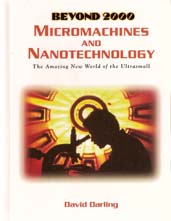MICROMACHINES AND NANOTECHNOLOGY: The Amazing New World of the Ultrasmall - Glossary
atom
The smallest particle of an element – a substance made up of only one type of atom. Examples of elements include iron, oxygen, carbon, and silicon.
current
The quantity of electricity flowing around a circuit.
diode
A very simple electronic component. Depending on the voltage of its two electrodes, a diode can pass or block a flow of electricity.
dopant
A substance used to alter the electrical properties of a semiconductor.
electrode
A piece of material that conducts electricity and allows an electric current to enter or leave a device.
electron
A particle found inside atoms. Electrons carry a single, tiny electrical charge. A lot of electrons moving together gives rise to a flow of electricity.
friction
The force that acts when any two surfaces come into contact and slide against one another. Friction can occur with solids, liquids, and gases.
integrated circuit
An arrangement of electronic components and connections manufactured on the surface of a single crystal of silicon. It is also known as a silicon chip or microchip.
LIGA
A fairly recent technique developed for making micromachines. LIGA uses X-rays to reproduce the very fine details of a micromachine and an electrical process to create the machine's parts from a metal such as nickel.
micro
A prefix, or beginning of a word, that comes from the ancient Greek term for "small." A microscope, for example, is used to look at very small objects. In scientific units of measurement, "micro-" stands for 1-millionth.
microchip
A silicon chip that contains many microscopic components.
micromachine
A microscopic-sized machine. The parts of such a machine may measure between a few micrometers and a few hundred micrometers across.
micrometer
One-millionth of a meter; also known as a micron. About 25,000 micrometers equal one inch.
miniaturization
The process of making things smaller in size.
molecule
A group of atoms joined together in a particular way. In most substances, a molecule is the smallest portion that can take part in a chemical reaction.
nano
A prefix, or beginning of a word, that comes from the ancient Greek term for "dwarf." In scientific units of measurement, "nano-" stands for one-billionth.
nanometer
One-billionth of a meter.
nanotechnology
The technique of building structures and machines from individual atoms and molecules.
nickel
A silvery white metal that is similar to iron. Nickel is a popular material for building micromachines because it can be laid down in very thin layers by a method called electroplating.
polysilicon
A form of silicon consisting of large numbers of small crystals.
polymer
A substance, either natural or artificial, consisting of long-chain molecules.
semiconductor
A substance whose ability to conduct electricity increases with rising temperature, and with the presence, in small quantities, of substances known as dopants.
silicon
A nonmetallic element that occurs as dark gray crystals. It is the most widely used semiconductor for making integrated circuits.
silicon dioxide
A substance that occurs naturally as sand. It can be formed as a layer by heating silicon to a high temperature. Unlike silicon, it will not conduct electricity at all.
torque
The total twisting force about a pivot.
transistor
A very important electronic component. The amount of electricity passing between two of the electrodes of a transistor can be accurately controlled by the voltage on a third electrode. This property allows transistors to be used either as control components or as switches.
triode
A device, made from metal electrodes inside a vacuum-filled glass tube, which is used to control a flow of electricity. Today, triodes have been largely replaced by transistors.
ultraviolet light
Light that is invisible to the human eye. It consists of waves that are shorter than those of violet light.
voltage
The force with which a flow of electricity is pushed around a circuit.
wavelength
A measure of the distance between the tops of two successive waves in a series of waves.
X-rays
Similar to the light that we can see but made up of much shorter waves. X-rays consist of waves that are even shorter than those of ultraviolet light.

